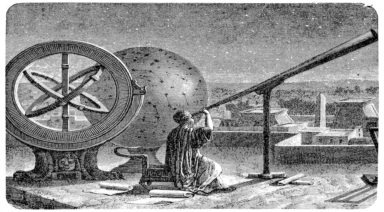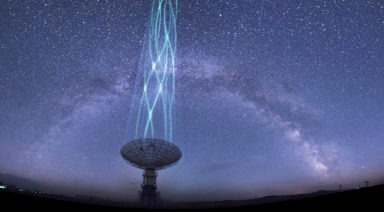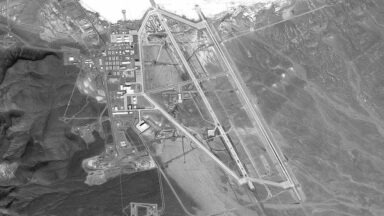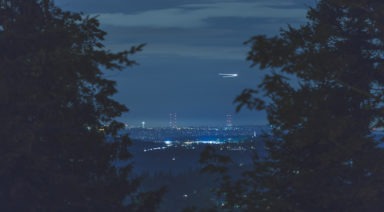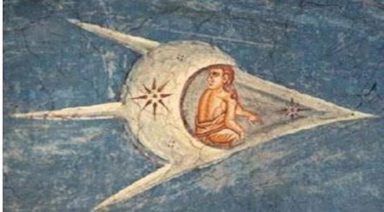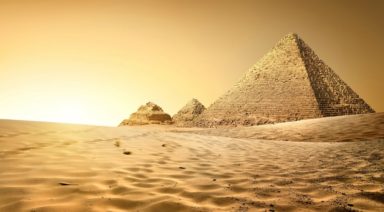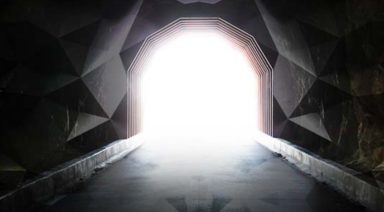Dyson Spheres Key to Find Alien Civilizations Higher on Kardashev Scale

Searching for intelligent life in the universe? Then look for their energy source. An update on the hunt for Dyson Spheres.
In June of 1960, astrophysicist Freeman Dyson published his paper Search for Artificial Stellar Sources of Infrared Radiation in the journal Science. In it he argued a way to detect intelligent life in the universe by finding their energy signature that would be created by, he presumed a highly advanced technology.
He wrote, “If extraterrestrial intelligent beings exist and have reached a high level of technical development, one byproduct of their energy metabolism is likely to be the large-scale conversion of starlight into far-infrared radiation.”
Dyson, who died one year ago this month at age 96, believed that an advanced technology would harness solar power from a star with an array of solar panels. He explained in a 2003 interview that he once described it as a biosphere, but since then this theory has been known as a Dyson Sphere.
Dr. Seth Shostak Sr. Astronomer at the SETI Institute explains, “If you’re looking for E.T., if you’re looking for intelligence elsewhere in the universe, you’ve got to figure there are societies out there that are way more advanced than we are, you know the universe has been around for a long time. And they may have constructed something like a Dyson Sphere, or more accurately a Dyson Swarm, or something we can see. And there have actually been searches for alien Dyson Spheres.”
Watch more:
Andromedans: Who They Are and How to Know If You’re One

The Andromedans are star beings from the Andromeda galaxy, known for their expanded consciousness and deep understanding of universal laws. Their mission on Earth is related to collective healing and the opening of new evolutionary pathways. In this article, we explore who the Andromedans are, their main characteristics, and how to identify if your soul shares this cosmic energy.
Table of Contents
- Who Are the Andromedans and Where Do They Come From?
- Main Characteristics of the Andromedans
- Are There Incarnated Andromedans on Earth?
- Is It Possible That Your Soul Has an Andromedan Origin?
- How to Contact the Andromedans and Receive Their Guidance
- Spiritual Practices to Open Yourself to Their Energy
- The Andromedans and Their Relationship with Other Star Races
- The Role of the Andromedans in Humanity’s Evolution
Who Are the Andromedans and Where Do They Come From?
The beings of light from the Andromeda galaxy, the closest one to the Milky Way, possess a high level of consciousness and a deep connection with cosmic laws, which allows them to actively participate in humanity’s expansion and the planet’s spiritual awakening. They act as cosmic guides and guardians of universal balance, transmitting teachings that strengthen the bond with the sacred and with unity.
These beings stand out for their capacity for vibrational healing and their respect for the diversity of life forms. It is said that their purpose includes sharing teachings that foster harmony between matter and spirit, promoting evolutionary processes that honor the essence of every being. Through lucid dreams, meditations, and spiritual practices, many people have felt the influence of the Andromedans in their lives, finding in them a beacon of wisdom and compassion.
In the series Initiation, available on Gaia, Matías De Stefano delves into cosmic history and the role that civilizations such as the Andromedans play in the expansion of consciousness. There, the multiple layers of reality are explored, and how these star races collaborate to guide humanity’s evolution and the construction of a new vision of the universe.
Main Characteristics of the Andromedans
The Andromedans possess spiritual and energetic qualities that distinguish them as cosmic guides and healers. Their influence may be felt in subtle ways, and their energy is perceived through dream encounters, deep meditations, or intuitive experiences. Below are some of their main characteristics:
- Expansive consciousness: They are deeply connected to the entirety of the cosmos. Their vision allows them to act from a place of unity and universal understanding.
- Peaceful energy: They radiate calm and serenity, acting as agents of balance in both personal and collective processes. Their presence helps to harmonize emotions and thoughts.
- Respect for diversity: They recognize the importance of every form of life and honor differences. Their mission is centered on inclusion and cooperation.
- Vibrational healing: They work with energetic frequencies to restore inner balance. They can influence physical, emotional, and spiritual health.
- Connection with higher dimensions: They communicate through dreams and meditations, offering guidance to those seeking to expand their consciousness. Their language is often symbolic and subtle.
- Cosmic orientation: They have deep knowledge of the universe’s evolutionary cycles. They help souls remember their purpose and align with universal laws.
- Unconditional love: Their vibration is based on respect, compassion, and cooperation. They serve as a reminder of the interconnection among all beings.
Are There Incarnated Andromedans on Earth?
Yes, there are incarnated Andromedans on Earth, living as human beings with the mission of contributing to the planet’s spiritual evolution. These souls carry the energetic frequency of Andromeda and are often drawn to topics related to the cosmos, healing, and personal transformation. Although they may not consciously remember their origin, their energy and actions reflect a purpose of service and expansion of consciousness.
These individuals often experience a strong sense of not belonging to this world, accompanied by a deep curiosity about the universe and realities beyond the physical. They usually have innate abilities for healing and energetic connection, and they seek to build bridges between spiritual knowledge and human needs. The connection with their star lineage manifests through dreams, meditations, and signs that confirm their purpose, reaffirming their commitment to harmony and peace.
The presence of incarnated Andromedans aims to anchor the energy of unity and harmony on Earth. By living with coherence and love, these souls activate codes of collective healing that help raise the planet’s vibration and guide others in their process of spiritual awakening. Their role is essential in maintaining energetic coherence and expanding collective consciousness. Every action and thought they emit strengthens the vibration of light and contributes to cosmic balance.
Is It Possible That Your Soul Has an Andromedan Origin?
It is possible that your soul has an Andromedan origin if you feel a deep connection with the universe and a constant desire to explore the mysteries of existence. People with this lineage often have a sharp perception of energies and a sense of purpose that goes beyond the earthly realm. These traits tend to appear early in life and intensify during moments of change or spiritual crisis, providing clarity about their life mission.
Another sign of an Andromedan origin is the inclination toward healing and the harmonization of energies, as well as the ongoing search for spiritual knowledge. These souls tend to see beyond appearances, feeling a need to help others reconnect with their essence and with the cosmic laws that govern life. Their sensitivity and openness lead them to develop practices that integrate body, mind, and spirit, and to always seek balance in every aspect of their lives.
To confirm this connection, you can have an Akashic Records reading. This tool allows you to access information about the journey of your soul and its cosmic origin, providing clarity and strengthening your connection with Andromedan energy. Knowing this information can help you align with your mission more confidently and fully manifest your potential in this lifetime. This practice is a powerful path to rediscovering your true essence and activating the gifts your soul has carried since its star-born origin.
How to Contact the Andromedans and Receive Their Guidance
Contacting the Andromedans requires a clear intention and an inner space of openness and respect. These beings communicate through subtle frequencies and often respond to those who seek to expand their consciousness and act from the heart. Creating moments of silence and reflection in your life is an essential step in perceiving their presence.
You can establish contact during deep meditations or through lucid dreams, where the conscious mind relaxes and perception expands. Visualizing the Andromeda galaxy and using sacred geometry symbols can facilitate this connection, serving as energetic portals to their vibration. Maintain an attitude of gratitude and humility so that Andromedan energy can flow naturally.
When receiving their guidance, pay attention to bodily sensations and signs in your environment. Their messages often arrive symbolically or intuitively, so it’s important to trust your perception and not force the process. Connection with the Andromedans strengthens with consistent practice and commitment to your own spiritual growth.
Spiritual Practices to Open Yourself to Their Energy
There are various spiritual practices that can help you open yourself to the energy of the Andromedans and strengthen your connection with them. These activities facilitate tuning into their vibration and allow their teachings to enter your life more clearly and lovingly. Here are some recommendations to begin integrating them into your daily life:
- Daily meditation: Set aside a few minutes for meditation to calm the mind and expand your perception. Visualize the Andromeda galaxy and allow its light to envelop you.
- Crystal work: Use crystals like celestite or labradorite to amplify the connection with higher dimensions. These crystals act as energetic bridges to cosmic frequencies.
- High-frequency music: Listen to sounds with higher frequencies or music that evokes cosmic harmony. These vibrations help align your energy field and attune you to the Andromedan vibration.
- Sacred geometry: Draw or meditate with symbols such as the Merkaba or Metatron’s Cube. These shapes contain universal patterns that activate cosmic consciousness.
- Conscious affirmations: Repeat affirmations that reinforce your intention to open yourself to the energy of the Andromedans. Spoken words and focused intention are powerful catalysts for manifesting this connection.
The Andromedans and Their Relationship with Other Star Races
The Andromedans maintain a close collaboration with other star races that share the purpose of guiding humanity toward its spiritual evolution. Each civilization contributes its unique frequency and wisdom, creating a network of cosmic support that sustains the planet’s transformation processes. Below are some of these connections:
- Pleiadians: Their energy is linked to unconditional love and emotional healing. Together, they foster heart-opening and the expansion of consciousness.
- Arcturians: They are experts in energy healing and managing high frequencies. Alongside the Andromedans, they help stabilize and protect energetic fields.
- Sirians: Their mission focuses on the activation of ancestral wisdom and the integration of sacred knowledge. This collaboration promotes the connection with humanity’s cosmic origins.
- Orions: Although they have been associated with cosmic conflicts, they now work with the Andromedans to heal ancient memories and move toward universal harmony.
- Lyrans: These beings bring the energy of creativity and manifestation. Together with the Andromedans, they guide the authentic expression of the soul’s purpose.
The Role of the Andromedans in Humanity’s Evolution
The role of the Andromedans in humanity’s evolution is centered on activating collective consciousness and remembering the connection with the universe. Their guidance encourages the opening to higher levels of perception and the understanding that everything is interconnected. Through their teachings, they help souls reconnect with their divine essence and manifest their true purpose on Earth.
These beings foster harmony and balance as pillars for spiritual transformation. Their presence stimulates the integration of cosmic knowledge with human needs, inspiring more sustainable and conscious ways of living. In doing so, they help humanity move toward a state of greater peace and cooperation, where respect and collaboration among all beings prevail.
By collaborating with other star races, the Andromedans strengthen the networks of light that support the planet. Their support becomes evident in times of change, helping people overcome fear, release old structures, and align with universal wisdom. With their loving guidance, humanity can embrace a more conscious, compassionate future aligned with the cosmic laws.




